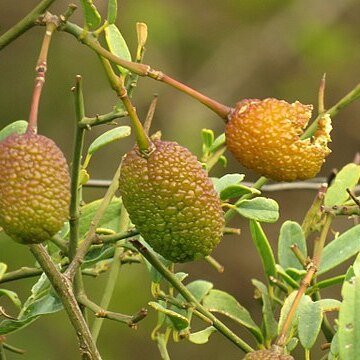Scrambling, sometimes much branched, shrub up to 3 m. tall with brittle glabrous branches.. Leaves petiolate, simple or 3-foliolate; blade lanceolate to broadly oblong-elliptic, 7–50 mm. long, 2–11 (–16) mm. wide, apically obtuse or somewhat acute, with the midrib excurrent, basally narrowed to rather rounded, glabrous, sometimes glaucous; petiole 3–10 mm. long.. Inflorescence terminal, racemose, few-flowered or the flowers 1–4 in the upper leaf-axils; pedicels 7–13 mm. long, thickening with age.. Sepals 11–15 mm. long, rather fleshy, glabrous outside, with a puberulent margin, sparsely lanate within; receptacle funnel-shaped, 3–4 mm. long.. Petals suborbicular or elliptic, ± 6 mm. long.. Stamens 27–38; filaments 13–25 mm. long, yellowish-white; anthers 2.2–3.5 mm. long.. Ovary rather shortly cylindrical or subellipsoid, glabrous.. Fruits ellipsoid, 2.5–3 cm. long, 1.5–2 cm. in diameter, apically rather rounded, verruculose, either almost smooth or rough, glabrous.
A scrambling shrub. It has many stems. It can be a climber. The branches arch over. It loses many leaves during the year. It can grow up to 15 m high. The leaves are alternate and grey-green. They have 1-3 leaflets. These are narrowly oval. The flowers are clustered near the ends of the branches. They are white. The petals are small and there is a half round head of long stamens. The fruit is oval and green to orange when ripe. Subspecies crustata has rough skin on the fruit and subspecies juncea has smooth fruit.
Leaves simple or 3-foliolate; leaflets 1–4.5 x 0.4–2 cm., oblong-elliptic, elliptic or lanceolate, apex rounded or subacute, mucronate, broadly cuneate or rounded at the base, often rather glaucous, nerves in 5–7 pairs, not conspicuous; petiole up to 2 cm. long; petiolules up to 5 mm. long, minutely puberulous on the upper side.
Inflorescence of 2–6-flowered lax racemes at the ends of the branches or solitary in the axils of the upper leaves; pedicels up to 4.5 cm. long; bracts trifid, setiform, caducous or like the leaves but usually simple and smaller.
Sepals 0.9–1.6 x 0.4–0.8 cm., narrowly obovate-oblong to oblong-elliptic, rounded at the apex and shortly mucronate, margin densely puberulous.
Petals white, 5–8 x 3.2–6.5 mm., broadly elliptic to orbicular or rotund, rounded at the apex or acute, shortly clawed at the base.
Small shrub or climber up to 15 m. tall, glabrous except for the sepal margins and petiolules; young branches green and striate.
Receptacle c. 5 mm. long and 4 mm. wide at the mouth with an undulate dentate disc at the mouth within, funnel-shaped.
Ovary on a gynophore up to 2.3 cm. long, oblong-cylindric; ovules c. 36 on 2 placentas; stigma sessile, capitate.
Stamens 20–30, on filaments up to 2.5 cm. long; anthers 2.5 x 1 mm., oblong.
Seeds 10–20, up to 8 mm. in diam., subglobose, testa rugose.
Fruit up to 3 x 2.5 cm., ellipsoid, smooth or roughened.
Androgynophore the same length as the receptacle.


